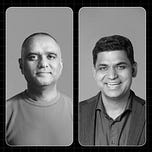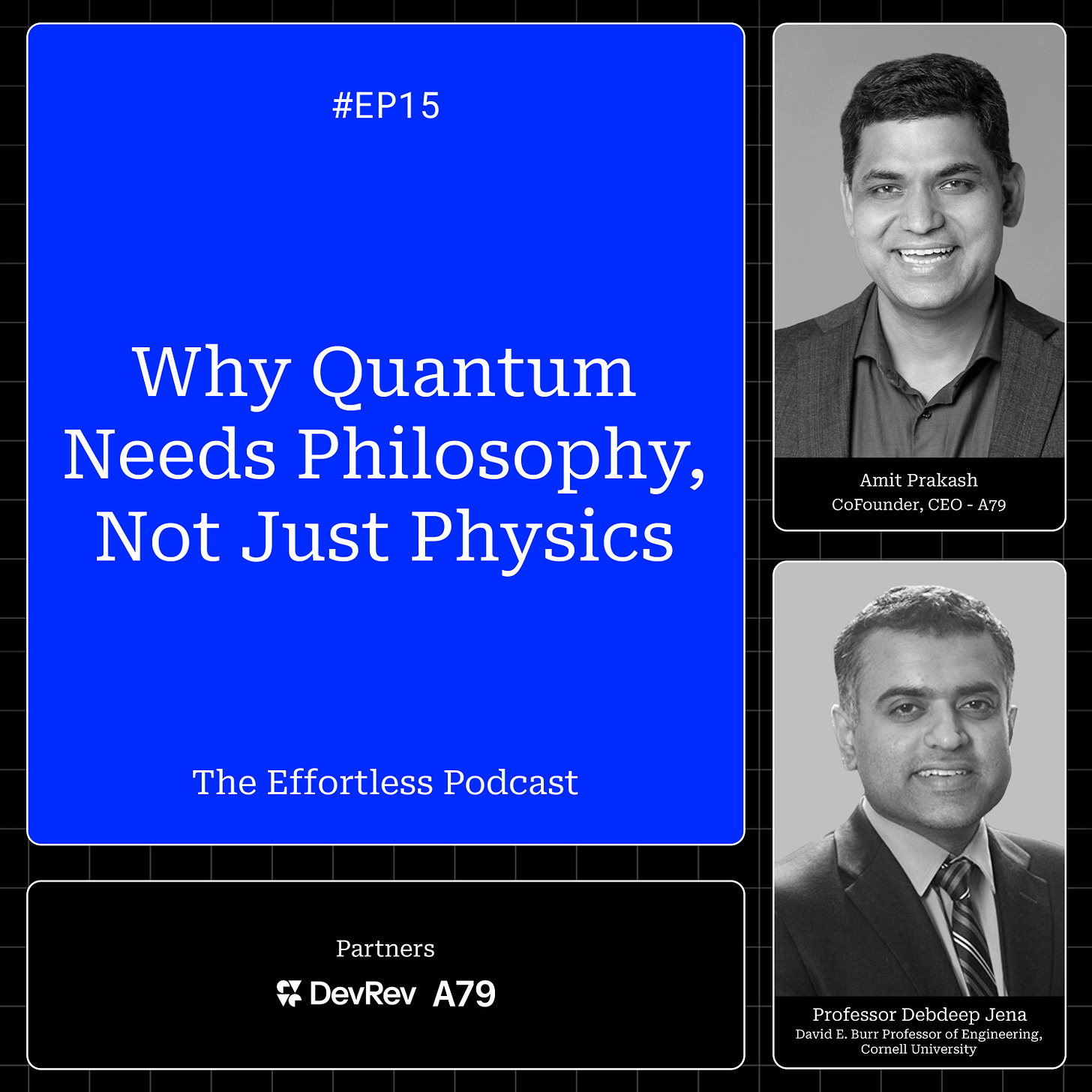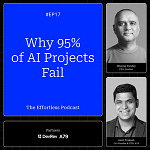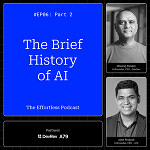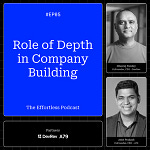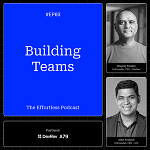Hosts
Amit Prakash – Co-founder and CTO of ThoughtSpot, former engineer at Google and Microsoft
Guest
Professor Debdeep Jena – David E. Burr Professor of Engineering at Cornell University, where he specializes in semiconductor physics, quantum devices, and energy-efficient technologies.
Summary
In this wide-ranging episode of The Effortless Podcast, Amit Prakash sits down with Professor Debdeep Jena to dive into the deep and sometimes mind-bending world of quantum physics and computation. Spanning the philosophical roots of Bell’s Theorem, the evolution of quantum algorithms, and the engineering reality of superconducting qubits, this conversation captures what it truly means to work at the frontiers of science and technology.
Debdeep brings clarity and candor to topics that are often mystifying, explaining how entanglement powers computation, why quantum error correction is even harder than it sounds, and how real devices—made of photons, atoms, and Josephson junctions—actually work. Along the way, he reflects on the future of hardware, the philosophical puzzles of measurement, and why he remains optimistic that quantum computing will scale to solve real-world problems.
Key Takeaways
Entanglement is real—and measurable. Experiments verifying Bell’s Theorem have repeatedly shown violations of local realism, with measured values around 0.85, confirming quantum mechanics over Einstein’s classical predictions.
Quantum computing needs entanglement to work. Without entanglement, quantum computation is not possible—even with qubits. It’s the source of quantum speed-up and scalability.
The origin of quantum computing was interdisciplinary. Physicists like Feynman and Peres started asking: Can quantum principles improve classical problems? This led to early algorithms in error correction and cryptography before Shor and Grover arrived.
Shor’s algorithm changed everything. By reducing prime factorization to a period-finding problem, Shor demonstrated a quantum speed-up that has direct implications for breaking RSA encryption.
Quantum error correction was once thought impossible. Due to the No-Cloning Theorem, error correction in quantum systems seemed doomed—until researchers like Shor proved it could be done with entangled redundancies.
Physical qubits aren’t logical qubits. You might need 1000 physical qubits to get 100 usable logical qubits—because of how much redundancy error correction requires.
Superconducting qubits are leading the pack. IBM and Google use superconducting transmon qubits, made of Josephson junctions and microwave cavities. These operate at 10 millikelvin in dilution refrigerators.
The coherence time bottleneck is real. Today’s transmon qubits have ~1 millisecond coherence time—barely enough to do serious computations. Extending this is one of the biggest hardware challenges.
Error correction and interconnects are harder than building qubits. It’s not just the qubit itself—it’s the control, read/write, and signal routing that make scaling to thousands of qubits hard.
Different quantum hardware paths exist. Besides superconductors, there are trapped ions, spin qubits (quantum dots), and Rydberg atoms. Each has trade-offs in size, temperature, and scalability.
Quantum computers are not futuristic—they’re here. Cloud-accessible machines from IBM already run real algorithms. The future lies in scale, coherence, and finding more practical quantum use cases.
You need both physics and CS to advance quantum computing. Hardware must evolve with algorithms. This is not just an engineering problem—it’s a co-design challenge between materials science and computation.
Quantum intuition breaks classical logic. The Schrödinger’s Cat and double-slit experiments challenge our classical notions of causality and observation. You can’t “peek” at quantum reality without changing it.
In-Depth Insights
1. The Birth of Quantum Mechanics and the Blackbody Radiation Puzzle
The episode begins with a fascinating exploration of the origins of quantum mechanics, beginning with Max Planck’s work on blackbody radiation in the early 20th century. Scientists were puzzled by the behavior of light emitted by hot objects, like steel ovens, which didn’t align with classical theories. Planck’s breakthrough was to introduce the concept of discrete energy packets (later termed “quanta”) to explain the radiation patterns. This radical idea was counter to classical thermodynamics, where energy was thought to be continuous. By quantizing the energy levels, Planck resolved the ultraviolet catastrophe, a discrepancy in the classical understanding of radiation, and laid the groundwork for quantum mechanics.
2. Einstein's Contributions: Photoelectric Effect and the Dual Nature of Light
Albert Einstein, though best known for his work on relativity, also made groundbreaking contributions to quantum mechanics, particularly with his explanation of the photoelectric effect. By applying Planck’s idea of quanta to light, Einstein showed that light behaves both as a wave and a particle, which was a fundamental shift in how scientists understood light’s nature. This marked one of the first major realizations of the wave-particle duality, a cornerstone concept in quantum theory. Einstein’s explanation of the photoelectric effect earned him the Nobel Prize and provided further evidence of the quantization of energy.
3. The Bohr Model: Quantum Physics Meets the Atom
As the field of quantum mechanics evolved, Niels Bohr developed a model to explain the hydrogen atom. Using quantum principles, Bohr proposed that electrons occupy specific energy levels or orbits around the nucleus, and they can only exist in these discrete states. The Bohr Model successfully explained the sharp spectral lines observed in the hydrogen atom’s emission spectrum. While this model worked for hydrogen, it had limitations, particularly when extended to multi-electron atoms. However, it was a significant step in moving away from classical models and incorporating quantum mechanics into atomic theory.
4. Qubits and Quantum Computing: The Promise of Parallelism
Fast forward to the present day, and the conversation turns to quantum computing—a field that harnesses the strange properties of quantum mechanics, like superposition and entanglement, to perform computations in fundamentally different ways. Traditional bits in classical computers are either 0 or 1, but qubits can be in a superposition of both 0 and 1 simultaneously. This ability to exist in multiple states at once allows quantum computers to process vast amounts of data in parallel, making them exponentially more powerful for certain types of problems than classical computers. However, constructing stable, scalable qubits remains a significant challenge.
5. Superconducting Qubits and the Challenges of Coherence
The episode dives deep into the current quantum computing hardware used by companies like Google and IBM, particularly superconducting qubits. These qubits are based on Josephson junctions, which allow for the flow of current through an insulating barrier between two superconducting materials. Superconducting qubits work by encoding information in the quantum state of a superconducting circuit, typically operating at microwave frequencies. Despite their promise, a major challenge is the coherence time—the time a qubit can maintain its quantum state before it becomes corrupted by environmental noise. Today’s superconducting qubits have coherence times in the millisecond range, which is far from the hours required for large-scale computation.
6. Quantum Entanglement: The Key to Quantum Power
One of the most mind-boggling concepts discussed in the episode is quantum entanglement, where qubits become intertwined such that the state of one qubit directly affects the state of another, no matter the distance between them. This phenomenon is famously referred to as "spooky action at a distance" by Einstein, who found it puzzling. However, quantum entanglement is essential for the power of quantum computers, as it allows for complex correlations and computations to be performed simultaneously. Quantum error correction also relies on entanglement, ensuring that the quantum information doesn’t degrade over time due to noise.
Host Biography
Amit Prakash
Co-founder and CTO of ThoughtSpot. Formerly an engineer at Google and Microsoft. Amit has deep expertise in distributed systems, data platforms, and machine learning.
LinkedIn | X (Twitter)
Guest Biography
Professor Debdeep Jena
Debdeep Jena is the David E. Burr Professor of Engineering at Cornell University, where he specializes in semiconductor physics, quantum devices, and energy-efficient technologies. His research focuses on the intersection of quantum physics with electronics and photonics, aiming to improve computation, memory, and energy management. Debdeep has published over 300 papers and holds multiple prestigious awards, including the Intel Outstanding Research Award (2020).
LinkedIn
Episode Breakdown
{00:00:00} Introduction to Debdeep Jena – Amit introduces his longtime friend and guest, Professor Debdeep Jena from Cornell University, highlighting his expertise in semiconductor physics, quantum computing, and superconductors.
{00:04:00} A Special Personal Connection – Amit shares his personal history with Debdeep, recalling how his class notes helped him graduate and emphasizing Debdeep’s passion for diving deep into any subject.
{00:06:30} Setting the Stage: The Origins of Quantum Physics – Debdeep explains the foundational problems in physics in the late 1800s and early 1900s, specifically the issue with black body radiation and how it led to the birth of quantum mechanics.
{00:11:00} Max Planck and the Quantum Leap – Debdeep discusses Max Planck’s contribution to resolving the black body radiation problem, introducing the concept of quantized energy and marking the birth of quantum mechanics.
{00:15:00} The Birth of Quantum Mechanics – Debdeep dives into how Planck’s quantum concept revolutionized physics and paved the way for Einstein and others to further develop quantum theory.
{00:22:00} Einstein’s Role in Quantum Theory – Debdeep explains Einstein’s work on the photoelectric effect and how it supported the idea of light to develop quantum theory further being quantized into photons.
{00:29:00} Bohr’s Model and the Hydrogen Atom – The conversation shifts to Niels Bohr’s revolutionary model for the hydrogen atom, explaining how quantization of electron orbits solved the problem of atomic spectra.
{00:34:00} From Classical to Quantum Mechanics – Debdeep transitions into the conceptual leap from classical to quantum mechanics, focusing on the discovery that atomic energy levels are quantized.
{00:41:00} Entanglement and EPR Paradox – The discussion moves to the famous Einstein-Podolsky-Rosen (EPR) paradox and the concept of quantum entanglement, which challenged classical ideas of locality and realism.
{00:47:00} Schrödinger’s Wave Equation – Debdeep introduces Erwin Schrödinger’s wave equation and the wave-particle duality that is fundamental to understanding quantum systems.
{00:54:00} Quantum Superposition and Qubits – Debdeep explains the concept of quantum superposition and how it leads to qubits, the fundamental unit of quantum computation.
{00:58:00} Understanding Qubit Entanglement – The conversation delves deeper into how entanglement works in quantum computing and how two qubits can be correlated in ways that are impossible in classical systems.
{01:07:00} From Theory to Practice: Quantum Computing and the Future – Debdeep discusses the potential of quantum computing, including applications in solving complex problems in chemistry, AI, and cryptography that classical computing cannot address.
{01:13:00} The Current State of Quantum Computing – Debdeep gives a snapshot of where quantum computing stands today, discussing the various approaches being developed (superconducting qubits, trapped ions, etc.).
{01:20:00} Challenges in Scaling Quantum Systems – The focus shifts to the physical challenges of building large-scale quantum computers, including maintaining qubit coherence and minimizing errors in quantum operations.
{01:27:00} Quantum Error Correction and Its Importance – Debdeep explains the significance of quantum error correction and how it’s a major hurdle in building reliable, large-scale quantum computers.
{01:35:00} Future of Quantum Computing: Potential and Vision – Debdeep shares his optimistic vision for the future of quantum computing and how the technology might evolve to tackle real-world problems more efficiently than classical systems.
{01:43:00} The Philosophical Side of Quantum Mechanics – The conversation takes a philosophical turn, reflecting on the inherent mysteries and paradoxes of quantum mechanics, including Schrödinger’s cat thought experiment.
{01:52:00} Final Thoughts – The conversation wraps up with Debdeep emphasizing the importance of understanding quantum mechanics and quantum computing as we move into an era where these technologies are set to revolutionize various industries.
References and Resources
Max Planck’s Blackbody Radiation Theory (1900)
Max Planck’s groundbreaking work on blackbody radiation introduced the idea that energy is quantized, meaning it can only exist in discrete packets or "quanta." This theory resolved the ultraviolet catastrophe that classical physics couldn't explain. Planck's constant, introduced in this work, became a fundamental feature in quantum mechanics. His findings paved the way for quantum theory, impacting subsequent discoveries by Einstein and others.
Learn more: Max Planck's Blackbody Radiation Theory
Albert Einstein's Photoelectric Effect (1905)
Einstein extended Planck’s ideas by showing that light behaves not only as a wave but also as particles called photons. His explanation of the photoelectric effect demonstrated that light's energy is transferred in discrete amounts. This work, for which he won the Nobel Prize, helped solidify the quantum nature of light, challenging classical notions of continuous energy transfer and laying the foundation for the quantum revolution.
Learn more: Einstein's Photoelectric Effect
Niels Bohr’s Model of the Hydrogen Atom (1913)
Bohr developed a model of the atom where electrons occupy discrete energy levels or orbits. This model explained the discrete spectral lines observed in hydrogen’s emission and absorption spectra. Bohr's work introduced the concept of quantized orbits for electrons, which was a significant departure from classical mechanics and essential for the later development of quantum theory.
Learn more: Bohr's Model of the Atom
Shor’s Algorithm for Prime Factorization (1994)
Peter Shor’s algorithm revolutionized the field of quantum computing by providing a polynomial-time method to factor large integers, a task that would take classical computers an impractical amount of time. This algorithm has profound implications for cryptography, as many cryptographic systems, like RSA, rely on the difficulty of prime factorization for security. Quantum computers using Shor’s algorithm could potentially break these encryption systems.
Learn more: Shor's Algorithm Explained
BB84 Quantum Key Distribution Protocol (1984)
Developed by Charles Bennett and Gilles Brassard, BB84 is a protocol that uses quantum mechanics to enable secure communication. It relies on quantum superposition and entanglement to detect eavesdropping. If a third party tries to intercept the quantum key being exchanged, the very nature of quantum measurement ensures that the presence of the intruder is detected, making BB84 a cornerstone of quantum cryptography.
Learn more: BB84 Quantum Key Distribution
Bell’s Theorem and Quantum Entanglement (1960s)
John Bell’s theorem showed that quantum mechanics could produce results that defy classical ideas of local realism, which posited that information cannot travel faster than the speed of light. Bell proved that quantum entanglement—where particles are instantaneously correlated, regardless of distance—violates local realism. This concept of entanglement has profound implications for our understanding of space, time, and reality itself, and is fundamental to quantum computing and quantum communication.
Learn more: Bell’s Theorem
Qiskit – IBM’s Quantum SDK
Qiskit is an open-source quantum computing software development kit (SDK) developed by IBM. It allows researchers and developers to write quantum algorithms using a high-level programming language, simulate them on classical hardware, and run them on real quantum processors available on the IBM Quantum Experience cloud platform. Qiskit simplifies the process of building quantum applications and serves as a bridge for classical developers to enter the quantum realm.
Learn more: Qiskit
Condensed Matter Physics
Condensed matter physics is the study of the physical properties of matter in condensed phases, such as solids and liquids. It covers phenomena like superconductivity, magnetism, and quantum fluids, which are essential for understanding how quantum systems behave at the macroscopic level. Many principles from condensed matter physics, such as the behavior of electron interactions, are directly applied to the development of quantum computing technologies, particularly in the creation of quantum devices.
Learn more: Intro to Condensed Matter Physics
Superconducting Qubits and Josephson Junctions
Superconducting qubits are one of the most widely explored forms of qubits in quantum computing. These qubits leverage the Josephson junction, a quantum device made up of two superconductors separated by a thin insulating barrier. Superconducting qubits operate in a microwave frequency range and rely on quantum superposition and entanglement to perform computations. This technology is used in leading quantum computers, including those by companies like IBM and Google.
Learn more: Superconducting Qubits
The Double-Slit Experiment
The double-slit experiment is a fundamental demonstration of quantum mechanics, showing the wave-particle duality of matter and light. When particles like electrons are sent through two slits, they create an interference pattern typically associated with waves, not particles. This paradoxical behavior challenges our classical understanding and is central to the concept of quantum superposition, where particles can exist in multiple states simultaneously until measured.
Learn more: Double-Slit Experiment
Grover’s Algorithm for Unsorted Database Search
Grover's algorithm is a quantum algorithm that allows for faster searching of unsorted databases. Classical search algorithms require O(N) time to find a specific item in a database of N items, while Grover’s algorithm reduces this to O(√N), offering a quadratic speedup. Although it is not exponential, Grover’s algorithm represents a significant advantage for certain computational tasks, especially when applied to large-scale data searches.
Learn more: Grover’s Algorithm Overview
Conclusion
In this episode, we journeyed through the rich history and cutting-edge developments of quantum physics and quantum computing, guided by the expertise of Professor Debdeep Jena. We learned how concepts like Planck's quantum of energy, Einstein’s photoelectric effect, and Bohr's atomic model laid the foundations for the transformative field of quantum mechanics.
From the early struggles of explaining atomic spectra to the birth of quantum theory, each breakthrough in the 20th century has pushed our understanding of the universe to new heights, culminating in the possibility of quantum computing—a technology poised to revolutionize everything from encryption to artificial intelligence. Through the lens of quantum physics, we’ve seen the dramatic shift in how we think about computation, from classical bits to quantum bits, or qubits, which possess the ability to exist in superpositions and be entangled across vast distances.
What’s truly exciting, however, is that this conversation isn’t just theoretical—it’s unfolding in real-time. With advancements in superconducting qubits, trapped ions, and quantum communication protocols like BB84, we are closer than ever to realizing the potential of quantum computing.
The journey of quantum computing is still in its early days, but the momentum is undeniable, and the future promises even more profound discoveries as we learn to harness the strange and beautiful principles of quantum mechanics.
Subscribe to Effortless for more conversations at the intersection of science, technology, and invention.

